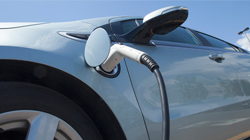As electric vehicles (EVs) gain popularity in the United States and policies to encourage EV sales are implemented, significant research has been done on reductions in global warming emissions and oil use associated with operating them. This includes research published in the Union of Concerned Scientists’ report State of Charge. However, the broader impacts of EV production and recycling remain less well characterized, and are important when assessing the total environmental impact of consumer vehicle choices.
The importance of life cycle assessment
Life cycle assessment (LCA) is a method to analyze the total impacts of a good or service. This analysis is often termed “cradle-to-grave” as it includes the extraction of raw materials used to make a product all the way to the disposal or recycling of the product at the end of its useful life.
This post is part of a series on National Drive Electric Week.
The impacts most commonly measured are costs, energy, and emissions. The LCA of costs is a standard business tool, as accounting for all the costs of a good or service is necessary to determine if a good or service will be profitable and competitive. More recently, energy and emissions have become a larger part of the LCA dialogue spurred by growing concern of climate change and local health impacts.
LCA is important because it helps decision makers (whether policy makers, businesses, or consumers) better understand the true impacts of a given good or service. When the goal is to optimize or reduce the total costs, energy, or emissions, it is critical to look at the process holistically to avoid negative tradeoffs and unforeseen consequences. More information on this can be found in my previous LCA post.
Applying LCA to advanced vehicles
The largest source of global warming emissions from conventional internal combustion engine vehicles comes from the tailpipe when the vehicle is in use. Battery-electric and fuel cell vehicles, on the other hand, do not have an internal combustion engine and thus generate no global warming emissions during operation. However, there are emissions associated with production of EVs and the fuel used to power them (electricity or hydrogen) that would increase the total global warming emissions associated with using the vehicles.
Emissions from fuel production
Regardless of whether EVs run partially or fully on electricity, producing the electricity used to charge them can generate global warming emissions. In State of Charge, my colleagues found EVs’ global warming emissions vary significantly based on the mix of energy sources used to power a region’s electricity grid. And just recently my colleague updated the main findings with the most current electricity data. Overall, the report finds, nationwide, EVs charged from the electricity grid produce lower global warming emissions than the average new compact gas-powered vehicle (with a fuel economy of 28 miles per gallon)—even in regions powered primarily by coal.In regions with greater proportions of renewable energy resources, EVs produce fewer global warming emissions than even the most fuel-efficient hybrids.
Emissions from manufacturing and recycling
Since the State of Charge report, questions around EVs’ manufacturing- and recycling-related global warming emissions have become more prominent. While recent research suggests the additional components required for EVs (e.g., large battery storage) increase life cycle emissions, the increase is not sufficient to negate the environmental benefits of EVs over their lifetimes. Most studies agree U.S. EVs are cleaner than conventional vehicles, but how much cleaner is still being researched. However, the relative importance of manufacturing and recycling to overall vehicle emissions increases as cleaner sources of electricity generation are added to the grid and the emissions generated by using EVs decreases. In addition, mass-market EVs are in an early stage of deployment and new EV models with different technology approaches (e.g., range, battery chemistry, body design and materials) are rapidly entering the market. Manufacturing processes are likely to evolve and mature over the coming years, as are recycling processes that could change the amount of EV materials being recycled, reused, or scrapped.
At UCS I am investigating the impacts of current and future trends in manufacturing and recycling EVs in order to more fully assess the current and potential future emissions of these vehicles over their entire life cycle. This research, along with fuel-production research already published, is critical to determining how much EVs can contribute to reducing global warming emissions and oil use. So stay tuned!

